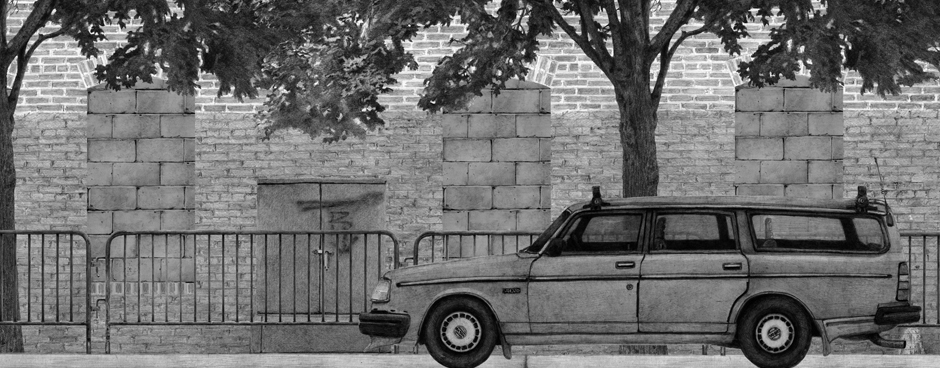
Baltimore, Maryland based artist Gary Kachadourian creates intricate pencil drawings of everyday objects and landscapes that are designed to be copied, shown, and/or distributed as Xeroxed or laser printed booklets, prints, posters, or objects. Much of his work is available to purchase for under $10 and is xeroxed to life-size scale. His current exhibition,Tree Lined Street, is on view in our main gallery space through September 4.
Gary was gracious to answer some questions from us about his work and his process.
The first time we encountered your work was in a zine show (the Rum Riot Press show in 2012). How does making books and zines interact with your installation part of your practice?
The current installation and the books in Rum Riot Press are parts of the same series of work. It starts with making small scale drawings of objects. Usually the life sized objects like in the installation or in posters are drawn on only one side. The drawings for books are drawn on all sides and designed to build as 3 dimensional models.
The fact that your work is often reproduced and reproducible allows a level of accessibility and interaction that isn’t often associated with contemporary art. What are your intentions in terms of accessibility?
The drawings are made to be reproduced, shown and sold as print outs, basically Xeroxs, so it is possible to make and sell them very inexpensively. They are also unlimited edition which cuts back on the exclusivity. So I just try to price them at what would be the “correct” price for an unlimited edition Xerox.
What’s your process like? How do you decide what you want to draw, and what happens after that decision is made?
The process of selecting objects to draw is pretty non-analytical. It’s just things I pass by or experience that register visually with me. So for instance, there are networks of metal utility boxes in Baltimore that have printed woodgrain on their doors. At some point driving past them over and over you start to wonder why anyone would put woodgrain on an outdoor utility box and then it seems obvious that it should be recorded and drawn. So, after deciding to make a drawing of an object I take measurements and photographs of it. I use these to make the drawing which is usually on an 8 1/2″ x 11″ piece of paper. When finished the drawing is scanned and prepared to be printed. At this point there are 73 drawings in the series. The installation at SPACE utilizes 16 of the drawings that are pieced together in Photoshop to make the scenarios. In many cases the same drawing like the tree is repeated multiple times.
Can you talk about your early work and how you got started making things?
I grew up building plastic models of airplanes and cars so my early drawings were of airplanes and cars along with knights and castles, etc. For twenty years or so starting in art school I mostly did drawings or wood carvings of people doing fairly generic things in their fairly generic environments. These were rendered naturalistically or photographically using perspectival drawing principles. At some point I realized I was most interested in the smaller things that were secondary parts of the images like say a sofa in the background or a dandelion in the lawn so I just started doing pieces that were only those things. At about that point I also eliminated the perspectival aspect by drawing them from on side or drawing all sides individually. So, in the end, what I’m making now is very similar to the models of cars and airplanes I used to build.
Your current installation at SPACE sort of exists in these two worlds where it very much overwhelms the physical space and also performs as a background, almost like a theater set. What’s your relationship to illusion? How do you want these life-sized renderings to inform/alter/enhance the space they occupy?
I like that the installations feel like backgrounds or theater sets and there’s always the hope that they will become a kind of real/unreal environment that people will interact with.
What’s your interest in everyday objects? (Or, more broadly, how do you feel about the term ‘everyday’ to describe the subjects of your work?)
I guess they could be called everyday objects. I think of them as the things that are always there that no one looks at.
What’s inspiring your practice right now? Foods, books, films, other artists, etc?
I watch a lot of television especially when drawing. I like a lot of anime series largely because of the backgrounds, the weeds growing in the concrete cracks, dumpsters in the alley, electrical lines, etc. The drawing of the secondary details is pretty exquisite. I’m always impressed at how much care is taken rendering the peripheral parts of the environments that the narratives take place in. I also reread the Akira graphic novel series a lot for the same reasons.
What are your currently working on or researching?
I’m continuing to make new drawings of objects. I just finished one of a plastic rock utility cover. I’ve also started a new set of ink drawings of weeds that continue on a series of drawings I mostly did between 2004 and 2009. These are all designed to be xeroxed and tiled to make wall installations of lawns or fields. There are also a few other projects I’ve been doing like drawings of Middle Earth figures and motorcycle riders (like in Akira) for activity set booklets, drawings of guitar players from YouTube videos, and drawings of cars done in Ed Roth style mostly on request.

